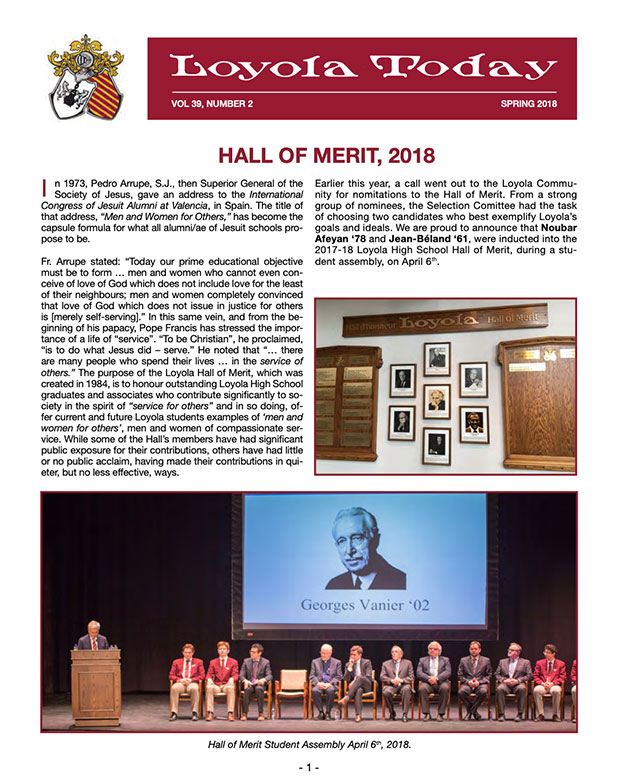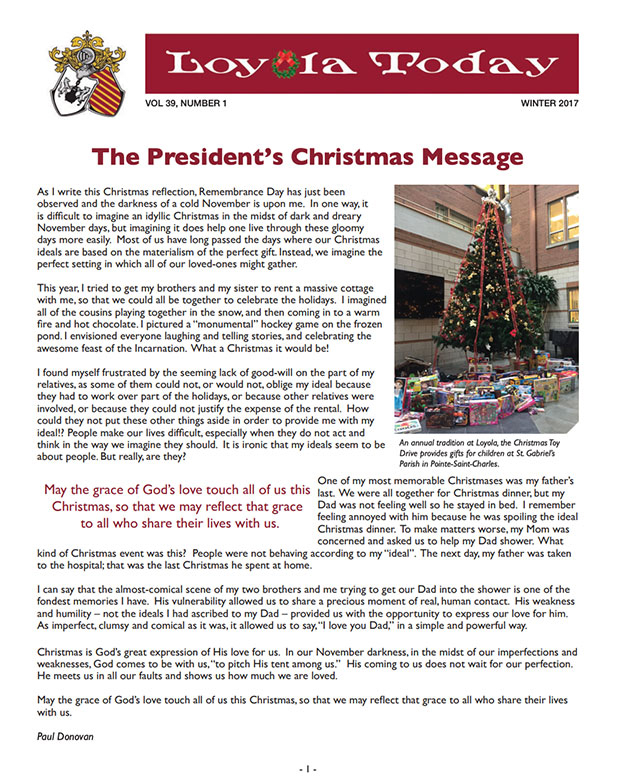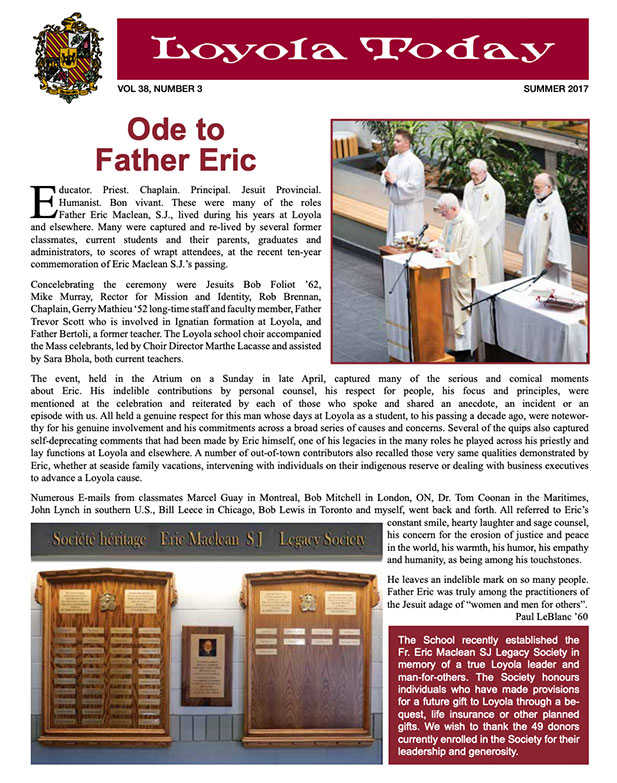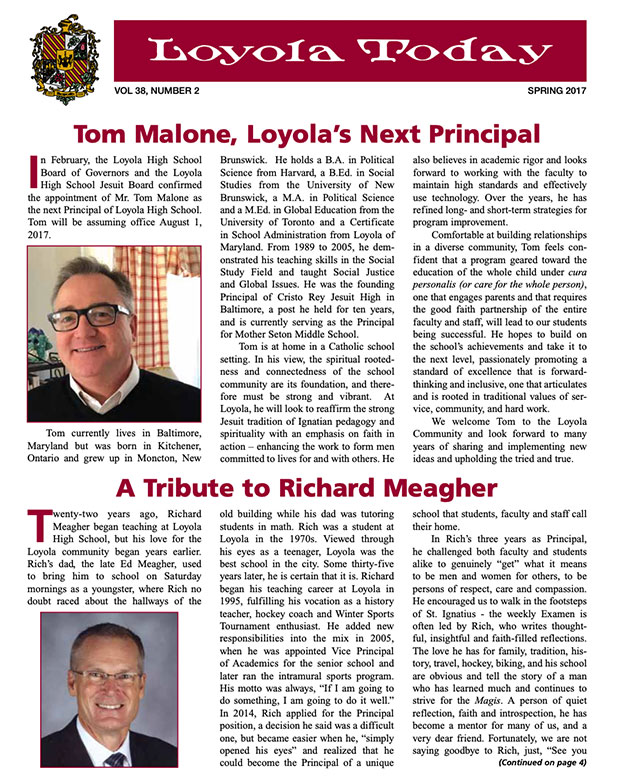Memoir/Article by John Ostopkevich '91
Part One: 1979-1988
The program began with one team only, and according to the ‘79 yearbook it was what looks like a midget-aged team coached by Mr. James McGrath. No blurb is available, a problem that recurred several times in my research over the decades of yearbooks (especially in those from 2005 to 2015), although I have been able to fill some gaps by interview, championship banners in team pictures, or by deduction from information given on prior and subsequent volleyball seasons. Note that all quotes are taken from Loyola Reviews or my own limited first-hand experiences, as indeed are most of the attributed spoken words, as well, unless otherwise specified.
The two Loyola v-ball teams of ’80 included bantams who, under McGrath, were described as ‘not…spectacular’, and, by contrast, a midget team, that won the GMAA (Greater Montreal Athletics Association) gold (Loyola’s first ever) under the same coach, assisted by a certain Terry White.
In the spring of ’81, the bantam team ‘came on strong at the end of the season’, but placed 3rd in their division, just short of a playoff berth. The midgets were a great 24-0 during the regular season, but lost to Northmount both in the Beaconsfield Volleyball Tournament and the GMAA finals. The juvies had only two players move up from the previous year’s midget champs. Their fate was to lose in the GMAA semis to Riverdale.
The spring of ’82 included a bantam team that my brother Mark played on which placed 3rd just as had the previous year’s bantams. Their coach was Mr. McGrath. For the midgets’ part, they ‘really got going at the end of the season’, but the team, coached by someone named Finn and a certain Mr. Reilly, lost in the GMAA finals to Northmount, 07-15, 11-15. No juvenile team is entered in the corresponding yearbook.
1983 saw the bantams bring gold home, following a 27-01 season. They were coached by Larry Ascoli (who was to be my sec. 1 math teacher 3 years later). They also played many exhibition games and were entered in multiple tournaments (no word on how they fared in these). They outplayed and beat Northmount in the GMAA semis, and topped Holy Names, thus becoming City Champions. The midgets had high hopes for gold at the season’s outset, however an injury to a key player coinciding with the addition of seven inexperienced add-ons hurt their chances. Their coach (Mr. Reilly) was quoted as saying that the team ‘showed a lot of class’. The juveniles, for their part, were reported as being consistently near-perfect all around, due to the excellent play of their team captain and having the best hitter in the league, yet fell by the smallest of margins, 14-16 in the tiebreak of the finals vs. LBP, taking home GMAA silver.
The fall of ’83 (v-ball became an autumn sport at this time) saw the bantam volleyball team, under Ascoli, who ‘guided us well through the season’, improve a lot through practicing together until becoming ‘good v-ball players’. But they lost in the finals to Northmount, good for silver only. The juvies, with a certain Lorne Pearson ‘helping greatly with their spiking’, ‘did well… considering the competition, but were inconsistent’. They ended up tied for third (presumably by losing in the semis), and were led by coach Reilly.
The bantams of autumn ’84, again coached by Ascoli, consisted of 17 players who ‘gave it their all until the final whistle’, but who went down into the books as going 00-02 up against Mount Royal in the semis. The midgets, for their part, ‘placed respectably in tournaments at McGill, l’Université de Sherbrooke, Vanier, and St.-Jérome’. Coach McGrath was assisted by Norman Graziani ‘83. They effectively led the midget boys to GMAA gold. The yearbook from that year includes the desideratum that ‘the caliber of Loyola’s competitiveness will be maintained’. As it would turn out, the prior success rate of Loyola’s volleyball teams would stay on as hoped, until the fall of ’88, at which point they would begin to qualify for the finals at an even more impossible rate (more than 90% of the time), right up until the scope of the present article maxed out (the fall of 2016). The juvenile team was ‘confident and enthusiastic’ at the beginning of the season, however due to ‘insufficient practice time’, they fell to Northmount in the GMAA semi-finals.
1985’s bantams went 26-02 in an 8-team division, despite losing a pre-season match ‘disastrously’, and ‘regrouped, changed tactics, and worked on basics’. They demolished Sir Wilfred Laurier in the GMAA semis, with Mr.McGrath coaching (assisted by Graziani and Ari Seropian), 15-03, 15-04. In the finals, they bested Northmount in a wacky-scored match: 15-03, 02-15, and 15-12, good for gold. The midgets were a team of ten players (including Robert Schnitzer ’88, who went on to both teach and coach at Loyola), under the then-new coach Kelly Burke. The juveniles, for their part, also coached by the McGrath-Graziani tandem, ‘met intense competition head-on’, placing first, sporting a 41-03 record.
The fall of ‘86 was a time of mourning for the school, as Loyola Volleyball’s premier advocate, the ‘earnestly enthusiastic, ‘Mr. Volleyball’ ’, who coached ‘with a sharing & gentle manner and in a wonderfully warm and caring way’, James McGrath, had passed on to the afterlife. In response, the midget team dedicated their season to him. The bantams, coached by Mr. Ruscito, who would go on to coach for the remainder of the scope of this article (the mainstay for the midget level from fall `88 to 2015) completed the season 22-04, placing 1st in their division, and were successful in capturing GMAA gold. The midgets, led very capably by Coach Burke, was made up of many returning players (although only 9 team members appear in the yearbook photo), won 40 games, and secured 3rd place at the provincials. The juvies, for their part, were in a rebuilding year, with no veteran players returning from that level, and only two midgets moving up. They narrowly missed the playoffs.
Autumn `87 was not a stellar year for Loyola Volleyball. The bantams engaged in no official league competition, but ‘ten late additions kept the flame alive’. The midgets, whom the yearbook reports as having had ‘a good year’, went into the playoff semis 18-06 for the regular season, only to be eliminated from medal contention by Mount Royal. Rookie coach McCarthy was quoted as declaring that ‘the team needs more experience to compete in the finals’. The juvies, for their part, coached by Burke assisted by Ruscito, had ‘an excellent season’, going 40-12, but lost in the finals. The success he was referring to was to win as many as seven GMAA golds and five silvers, out of a possible 26 for the ten-season period, this from spring of ’79 until fall ’87, inclusive. I suppose few knew that beginning in ’88, Loyola would up its game by a factor of more than two, capturing gold in more than 2/3rds of its upcoming opportunities, and making it to the finals more than 90% of the time.
In 1988, Mr. Burke was my homeroom teacher. It was a class with many strongly skilled athletes; we won interclass hockey, football, and lacrosse, among others, and, more importantly for me, our group gave me an opportunity to shine as the best volleyball player not on an interscholastic team, showing a bit of mastery of spiking and blocking rudiments, good bumping, decent setting, but most of all a fist-hit low floater from way back that got my team 5 to 8 points per set. We won every game handily to win the I-C (inter-class) pennant.
As for the bantams, midgets and juveniles of the fall of ’88, the yearbook photo displays only 5 bantam players, which would make for disqualification. It can be assumed that one or more players were simply absent or unavailable. Their season is described as ‘splendid’, with coach Balla’s ‘persistence with good game plans helping to get the team to the finals’. ‘A good team effort’ allowed them to claim silver. The midgets had a ‘sluggish start’, but finished 22-02, which gave them a bye directly into the GMAA finals, where they were victorious (just as Mr. Shnitzer had hoped).
Part Two: 1989-1997
In the fall of ’89 I had not much problem succeeding in making the midget team. I was named its MIP (Most Improved Player), although in the finals I was reduced to an observer, watching helplessly as we took home only silver. Unfortunately, this time, the prior year’s good wishes were futile. The bantams, coached by Mr. Bob Shaughnessy, consisted of 13 players who found, too, their way into the finals, while the juvies, under Coach Burke, ‘won, and what a great victory it was!’ (the obtaining of GMAA Gold).
For a change, I was a starter, even playing every minute of every league game, as soon as I had made the juvie team of ’90. Coach Burke is quoted as saying it was ‘an extremely successful season’. We were undefeated on home court, and posted a remarkable 60-09 record. My fondest memory from that season was barely winning the 1st set in a league game versus Maimonides 15-13, but next playing our strongest game of the year to a 15-0 victory in the second set. The midgets, under Mr. Ruscito, focused on ‘improving skills, discipline, and teamwork rather than winning’. The yearbook blurb includes that the season was ‘a definite success’. They won the John Abbott Invitational, but had to content themselves with GMAA silver. A further quote appears in the blurb: ‘Loyola’s future in midget v-ball looks promising’. The bantams, under coach Shaughnessy, won every game quite easily, with the exception of Lachine, against whom they were 01-02 during the regular season, and against whom they knew they would have to contend in the finals. A large crowd watched at the finals held at Vanier CEGEP. It was a best-of-five. They lost the first, third, and fourth sets, good for silver. It was a talented and dedicated team. I was to graduate in the spring of ninety-one, but not gone forever, walking in the steps of dozens of former students who have returned to assist in fostering greater sports skills, conditioning, adaptability, and a winning attitude.
The 1991 bantams, under Coach Shaughnessy, were tied neck-and-neck against Sir Wilfred Laurier during the regular season, with a record of 02-02 against them, and the rest of the league offering ‘no competition’. After going down two sets to the SWL team in the best-of-five final, they demonstrated resiliency by winning the next two to set the stage for the deciding game. In it, Loyola went down 14-16, so silver was awarded to this ‘talented and dedicated’ team. The midgets, who ‘improved throughout the season’ noticeably, finished in 1st place in their division. Their opponent in the GMAA finals was Wagar, who had snatched gold from Loyola for the prior three seasons. The Loyola midgets fared much as the Bantams had, by losing the 1st two sets, winning the next two, then losing by the smallest of margins, 13-15. Coach Ruscito ‘seemed satisfied, stating that the team had ‘come a long way’’. Silver again. The juvies did not share the misfortunes experienced by the younger teams that season. They were ‘perhaps the strongest juvie team… assembled [up to that date]’ at Loyola. Prompted by Coach Burke’s useful directives, they finished in 1st place and capped of the season by obtaining GMAA gold.
The fall of ‘92’s bantams, coached again by Mr. Shaughnessy, whose ‘knowledge and experience were a boon’ to the team, and, had a ‘stellar year’, finishing with a 27-03, and beating WIC in the finals for gold. That year’s midget team, consisting of one-half veterans and the rest rookies, had a slow start, but were number one in the standings come playoff time. Sadly, they ‘narrowly’ lost the deciding game in the championship best-of-three match. The juvies, for their part, with the guiding hand of Coach Burke, notched up a 5th GMAA gold in a row, this time against Hudson High, and wished ‘lots of luck’ for the next year’s team.
By 1993, Mr. Shaughnessy’s coaching had reached the hyperbolic description of ‘superb’. And with the help of Pierre Yongco, class of ‘92 (who happened to be the team manager and statistician my juvie year), the bantams defeated Royal West for GMAA gold. The midgets are reported as enjoying a ‘terrific year’, reaching an unbeaten regular season, and beating Wagar for GMAA gold. They were known as ‘the lunch-pail boys’. The juvies, for their part, are described as having had a ‘very productive year’. They claimed gold at both the Loyola and John Abbot tournaments, but saw the championship slip away in a 15-17 loss in the 3rd and deciding set versus John Rennie, and were awarded GMAA silver.
Then, from 1994’s autumn to that of 1997, Loyola Volleyball went 12 GMAA golds for 12 attempts, after qualifying for every final, and emerging as victors each time. This feat would be repeated from the season of 2003 to that of the fall of 2006. Below are some details and highlights from the twelve golds running from ’94-’97:
Fall 1994 Bantams: Champions. 29-01 for the regular season, and went 2-0 in the finals. ‘Talent, effort, and coaching were the winning formula’. Midgets: Champions. Cruised through the regular season, going 26-02. Juveniles: Champions. Finished the regular season with only 1 loss. ‘an awesome season’…this Loyola team was ‘an unstoppable dynamo’. ‘Thanks and congrats from the team to coaches Burke and assistant Vince Amato ’89’ for ‘successfully leading us to a championship’.
Fall 1995 Bantams: Champions. Sporting a 34-02 record for the reg. sea. Thanks to coaches Shaughnessy et. al. Midgets: Champions 21-03 reg. sea. & playoffs combined, despite having only three returning players. The players appreciated Coach Ruscito’s ‘equal playing time’ philosophy. Juveniles: Champions. Completed the reg. sea. sporting a 20-04 record. Thanks to Mr. Burke’s dedication and ability to inspire the team, the Loyola juvies breezed through the playoffs to victory.
Fall 1996: Bantams: Champions. Played an exciting brand of volleyball. ‘The setters’ ability to get the ball to our hitters enabled better spiking.’ The players wish to thank head-coach Mr. Bob Shaughnessy, plus assistants Yongco, Dupont, and Dutillio for their patience and devotedness. Midgets: Champions. The team won Loyola midgets’ fourth championship in a row at the GMAA level, and bench players had contributed significantly. Juveniles: Champions. This team’s success was due to the hard work and dedication of its players and coach (Mr.Burke).
Fall 1997: Bantams Champions. Same winning coaching recipe as 1996, same victorious result. Midgets: Champions. A 27-01 record for the reg. sea. They beat JFK for the 5th consecutive gold at the midget level. Juveniles: Champions. The ‘consistent play of five rookies’, along with 4 veterans whose hard work was not in vain. Coach Burke held the reins once again.
Part Three: 1998-2003N/A means the information remained unavailable to me despite my efforts.DNQ means that the given team did not qualify for the City Championship match.
Autumn 1998: Bantam: Champions, Midget: Silver medalists, Juvenile: Champions
Fall 1999: Bantam: N/A Midget: Silver medalists. Juvenile: N/A
Fall 2000: Bantam: Champions. Midget: N/A, Juvenile: N/A
Fall 2001: Bantam: Champions, Midget: Champions Juvenile: DNQ. ‘Played with heart, finished tops in the league,’ but lost in a tie-break in the semis, hence tied for 3rd.
Fall of 2002: Bantam: Result: 19-01. Midget: Obtained GMAA silver vs Howard S. Billings, Juvenile: 16-04 record. Practiced hard all season, until Coach Burke could find it probable that they could take home gold. Like a camel through the eye of a needle, they won vs Lindsay Place 25-23, 25-23 in the best-of-three, side-stepping a third and deciding set, and securing the gold.
Fall 2003: Bantam GMAA Champions. Keith Fitzpatrick’s 4th gold out of 4 seasons. Midget: Champions. Fought hard all season, but it was in the playoffs that they really shone. Juvenile: Champions under the tutelage of Coach Burke. These teams went 06-00 in the finals, setting the tone for 2004.
Part Four: 2004
One day I was at Concordia’s Loyola Campus volunteering as a graduate in the psych department located in a reconfigured Old Loyola Building, and, while waiting for the 105 bus, I noticed two LHS 14-year-olds ‘passing’ a volleyball, to and fro on the school lawn. I told one of them that I had been a Loyola volleyball player, and asked them how the program had been doing. One of the boys, the main setter and captain-to-be of that year’s midgets, replied, with gladness, that the school had swept gold. It was late August. I had a knee-jerk kind of thought, with my usual logic. It was that the season after a sweep, the opposition increased its efforts and resolved to unseat the champions. So, it occurred to me that they could use my help. We conversed no more, but, by the time I had gotten home, I had decided to call Mr. Bob Shaughnessy and ask if he wanted me as assistant coach for the bantam team. He replied that it was not he, but Principal Keith Fitzpatrick who was going to be head coach, and that I could fill the role of his second-in-command, instead. I agreed.
Tryouts for the bantam team of 2004 went extremely well. The players perfected skills in seconds or minutes that usually require years to attain. In the second-to-last game, the juvies were even 21-21. Game 84 was a 25-16 Loyola Juvie cakewalk. Victory seemed locked up securely as the Warriors grew in confidence and understanding. Losses came early in fall 2005 for the bantams and juveniles both, although it would be three years before Loyola would slip to a silver medal.
Instead of an outpouring of jubilation at the finish, Loyola evinced chagrin that it was over, as if they wanted to play on without interruption to rise to even greater heights. Students opted for black garments for the remainder of the winter, puzzlingly. Probably, it had to do with Principal Fitzpatrick’s revelation that he had melanoma, and that a cure was very unlikely. His death the next year was a huge loss to the Volleyball Program, and to the entire school community. Loyola had to march on, however, and did admirably.
Part 5: 2005-2006
Fall 2005: Bantams: Champions. Where Keith supported and facilitated my efforts, the new head coach undermined and scornfully opposed my approach to helping the team improve. We won gold by the minimum 4 points, and I cannot say I contributed much, as I was debilitated by a month-and-a-half of bronchitis during mid-season. Midgets: Champions. Mr. Ruscito took over the guidance of the four returning players from the ’04 bantam team. As mere sec.3s, they led the team to a second consecutive undefeated season, playoffs included. Juveniles: Champions. Cruised to gold under coach Kelly.
Fall 2006: Bantam: Champions. By this time I began coaching juvie. Coach Ani Beland won by the smallest possible margin, as she had the prior year. Evidence of my personal, nearly inadequate ineffectuality in 2005. Midgets: Champions. One of the 2004 bantams, then playing for Lindsay Place, put an end to the winning streak of the three remaining other 2004 players at around 80-00. Still gold medalists, happily. Juveniles: Champions. With greater coach-assistant coach synergy, the juvie warriors won gold in a game that went smoothly.
Part Six: 2007-2016
Fall 2007: Bantams: Champions, Midgets: Champions, Juveniles: Silver medalists
Fall 2008: Bantams: Champions, Midgets: Champions, Juveniles: Champions
Fall 2009: Bantam: Champions, Midgets: Champions, Juveniles: Silver medalists.
Fall 2010: Bantams: Champions, Midgets: Champions, Juveniles: Champions
Fall 2011: Bantams: Champions, Midgets: Silver medalists, Juveniles: Champions
Fall 2012: Bantams: Bantams: Champions, Midgets: Champions, Juveniles: Champions
Fall 2013: Bantams: Champions, Midgets: Silver medalist. Juveniles: Champions
Fall 2014: Bantams: Champions, Midgets: Champions, Juveniles: Champions Fall 2015: N/A
Fall 2016: Bantams: Champions Midgets: Champions, Juveniles: DNQ
The following stat reports the vaunted extant numbers from ’81-’05 league play (with a few exhibition and playoff results thrown in): 27 teams for which stats are available, and 49 others where final league results are nonexistent, but, for what it’s worth, Loyola racked up roughly 773 wins in summation of the available numbers, and endured only about 69 losses. Impressive in any sport at any level, to win more than 90% of the time! In total, from the fall of ’88 to that of ’16, inclusive (29 seasons X 3 teams = 87 golds possible), Loyola Volleyball claimed gold in at least 62 of them, failed to qualify for the finals twice, qualified for the bantam finals with an unknown result in the fall of ’89, may have won up to seven more medals in the seasons with no info available to me, and amassed at least 15 silvers along the way.
Thus does this article end, happily for some reasons, sadly for others. One thing is certain, however. No matter how bad the coaching might get, the plenitude of excellent juvies will ever inspire and serve as models for the midgets, and there will always be midget teams that will lead the bantams as exemplars (and not the reverse, which will only ever happen the one time (in the fall of 2004), I am sure), which involves an accumulated edge of winning habits that has accrued over the decades and that can wane but never disappear, and indeed may grow yet stronger.
Loyola Today
- Automne 2018

- Printemps 2018

- Hiver 2017

- Été 2017

- Printemps 2017

- Été 2016

Département des communications et médias
Contact
Chiara Folini-Buma
Directrice des communications et du marketing
communications@loyola.ca





